Taxation Assignment - Finance: Income Tax Assessment Act 1997
VerifiedAdded on 2022/10/18
|9
|1763
|15
Homework Assignment
AI Summary
This assignment analyzes the tax implications of Jane's income and expenses, based on the Income Tax Assessment Act 1997. It examines the assessability of her salary and teaching income, along with the deductibility of various expenses. The assignment evaluates travel expenses between home, office, and client locations, as well as home office deductions. It also considers the deductibility of membership fees, subscriptions, clothing, and education expenses. Finally, it determines Jane's capital gains from the disposal of personal and collectible assets, such as a yacht and antique furniture. The analysis uses relevant case law to support the conclusions regarding each issue.
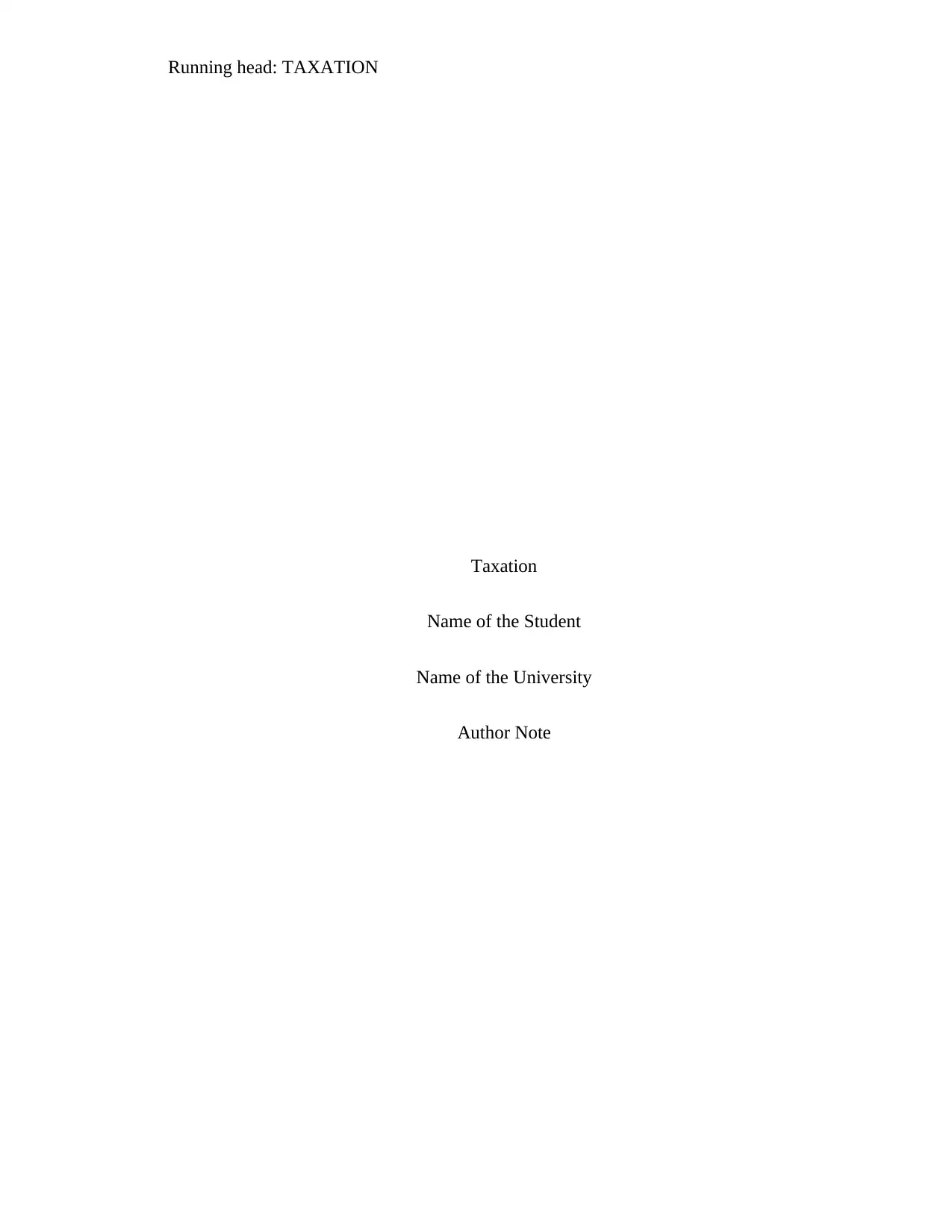
Running head: TAXATION
Taxation
Name of the Student
Name of the University
Author Note
Taxation
Name of the Student
Name of the University
Author Note
Paraphrase This Document
Need a fresh take? Get an instant paraphrase of this document with our AI Paraphraser
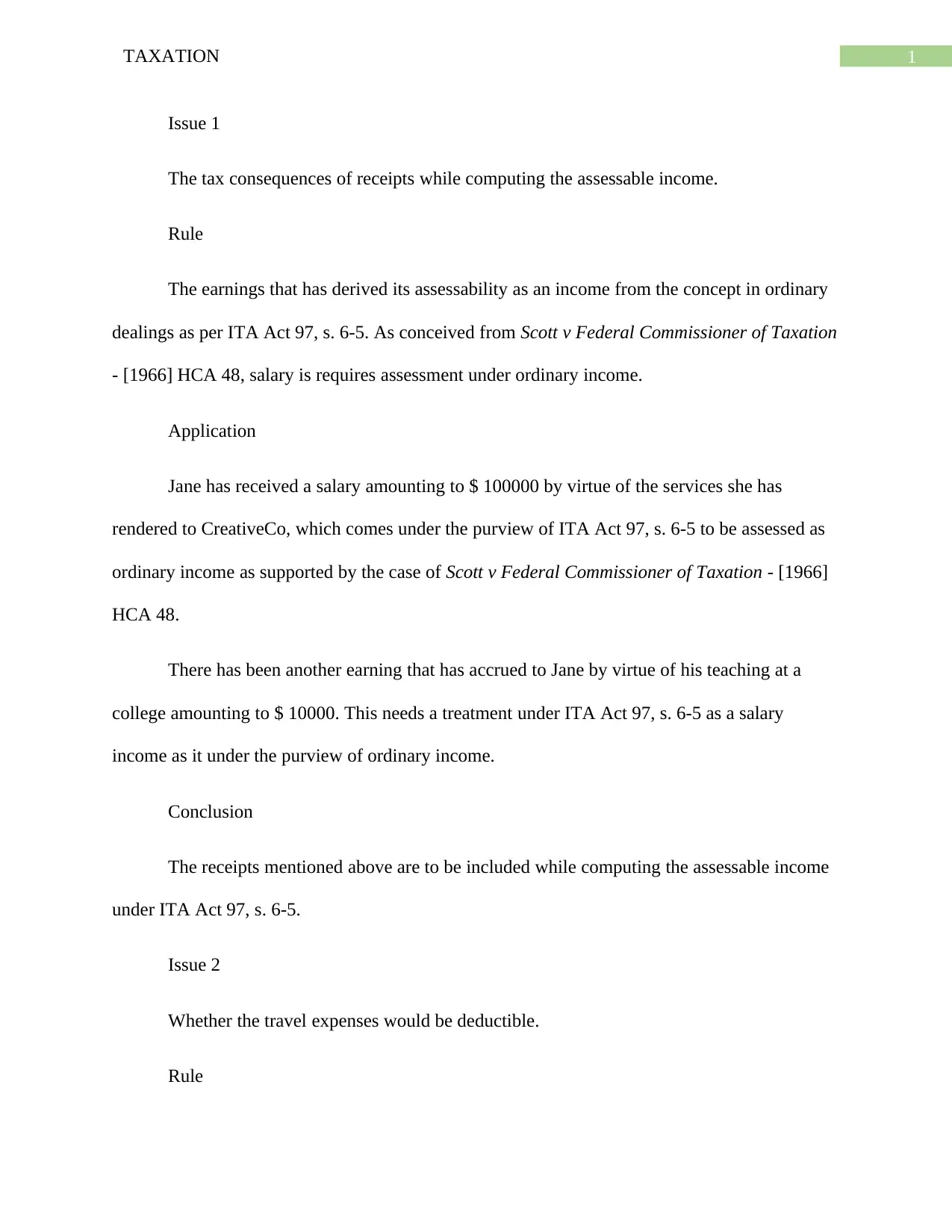
1TAXATION
Issue 1
The tax consequences of receipts while computing the assessable income.
Rule
The earnings that has derived its assessability as an income from the concept in ordinary
dealings as per ITA Act 97, s. 6-5. As conceived from Scott v Federal Commissioner of Taxation
- [1966] HCA 48, salary is requires assessment under ordinary income.
Application
Jane has received a salary amounting to $ 100000 by virtue of the services she has
rendered to CreativeCo, which comes under the purview of ITA Act 97, s. 6-5 to be assessed as
ordinary income as supported by the case of Scott v Federal Commissioner of Taxation - [1966]
HCA 48.
There has been another earning that has accrued to Jane by virtue of his teaching at a
college amounting to $ 10000. This needs a treatment under ITA Act 97, s. 6-5 as a salary
income as it under the purview of ordinary income.
Conclusion
The receipts mentioned above are to be included while computing the assessable income
under ITA Act 97, s. 6-5.
Issue 2
Whether the travel expenses would be deductible.
Rule
Issue 1
The tax consequences of receipts while computing the assessable income.
Rule
The earnings that has derived its assessability as an income from the concept in ordinary
dealings as per ITA Act 97, s. 6-5. As conceived from Scott v Federal Commissioner of Taxation
- [1966] HCA 48, salary is requires assessment under ordinary income.
Application
Jane has received a salary amounting to $ 100000 by virtue of the services she has
rendered to CreativeCo, which comes under the purview of ITA Act 97, s. 6-5 to be assessed as
ordinary income as supported by the case of Scott v Federal Commissioner of Taxation - [1966]
HCA 48.
There has been another earning that has accrued to Jane by virtue of his teaching at a
college amounting to $ 10000. This needs a treatment under ITA Act 97, s. 6-5 as a salary
income as it under the purview of ordinary income.
Conclusion
The receipts mentioned above are to be included while computing the assessable income
under ITA Act 97, s. 6-5.
Issue 2
Whether the travel expenses would be deductible.
Rule
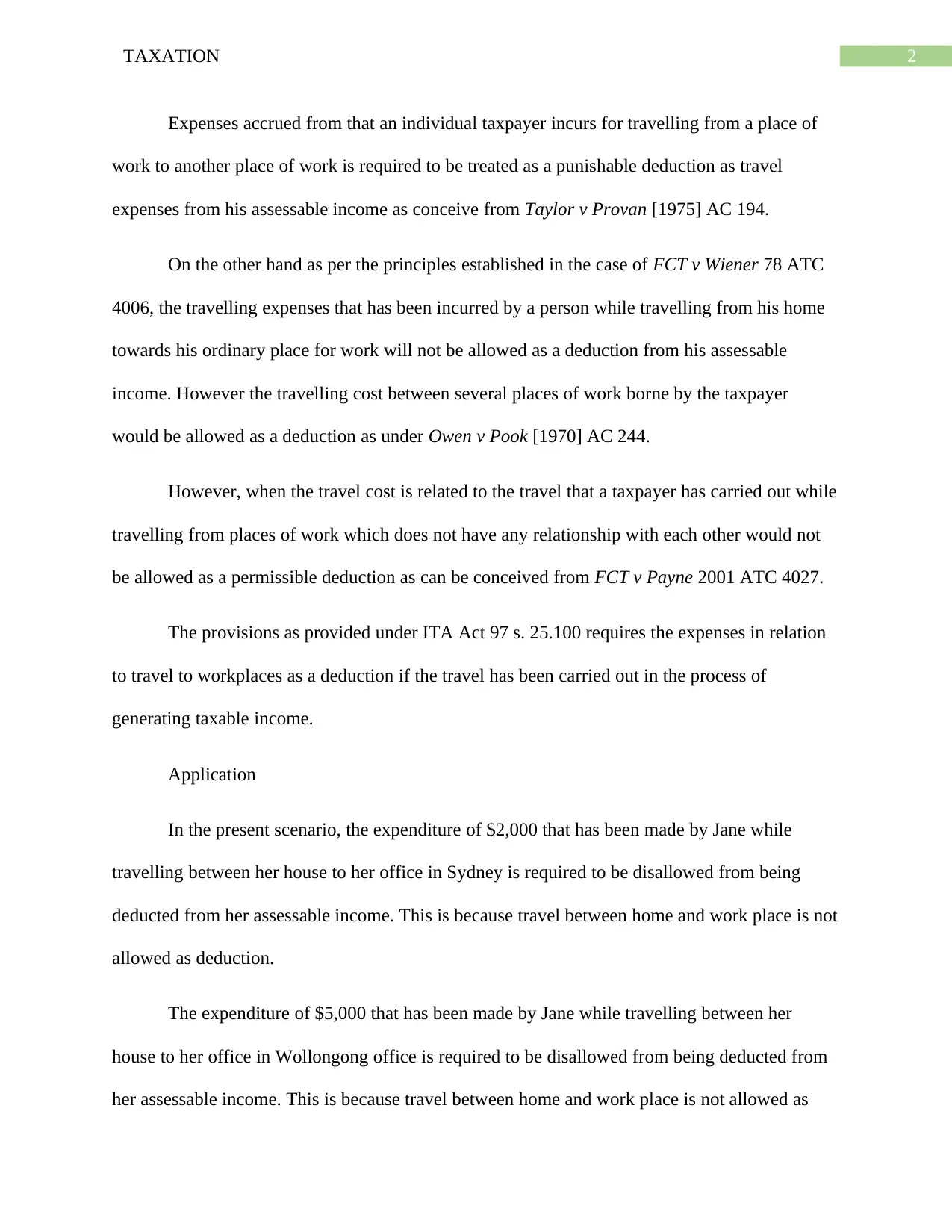
2TAXATION
Expenses accrued from that an individual taxpayer incurs for travelling from a place of
work to another place of work is required to be treated as a punishable deduction as travel
expenses from his assessable income as conceive from Taylor v Provan [1975] AC 194.
On the other hand as per the principles established in the case of FCT v Wiener 78 ATC
4006, the travelling expenses that has been incurred by a person while travelling from his home
towards his ordinary place for work will not be allowed as a deduction from his assessable
income. However the travelling cost between several places of work borne by the taxpayer
would be allowed as a deduction as under Owen v Pook [1970] AC 244.
However, when the travel cost is related to the travel that a taxpayer has carried out while
travelling from places of work which does not have any relationship with each other would not
be allowed as a permissible deduction as can be conceived from FCT v Payne 2001 ATC 4027.
The provisions as provided under ITA Act 97 s. 25.100 requires the expenses in relation
to travel to workplaces as a deduction if the travel has been carried out in the process of
generating taxable income.
Application
In the present scenario, the expenditure of $2,000 that has been made by Jane while
travelling between her house to her office in Sydney is required to be disallowed from being
deducted from her assessable income. This is because travel between home and work place is not
allowed as deduction.
The expenditure of $5,000 that has been made by Jane while travelling between her
house to her office in Wollongong office is required to be disallowed from being deducted from
her assessable income. This is because travel between home and work place is not allowed as
Expenses accrued from that an individual taxpayer incurs for travelling from a place of
work to another place of work is required to be treated as a punishable deduction as travel
expenses from his assessable income as conceive from Taylor v Provan [1975] AC 194.
On the other hand as per the principles established in the case of FCT v Wiener 78 ATC
4006, the travelling expenses that has been incurred by a person while travelling from his home
towards his ordinary place for work will not be allowed as a deduction from his assessable
income. However the travelling cost between several places of work borne by the taxpayer
would be allowed as a deduction as under Owen v Pook [1970] AC 244.
However, when the travel cost is related to the travel that a taxpayer has carried out while
travelling from places of work which does not have any relationship with each other would not
be allowed as a permissible deduction as can be conceived from FCT v Payne 2001 ATC 4027.
The provisions as provided under ITA Act 97 s. 25.100 requires the expenses in relation
to travel to workplaces as a deduction if the travel has been carried out in the process of
generating taxable income.
Application
In the present scenario, the expenditure of $2,000 that has been made by Jane while
travelling between her house to her office in Sydney is required to be disallowed from being
deducted from her assessable income. This is because travel between home and work place is not
allowed as deduction.
The expenditure of $5,000 that has been made by Jane while travelling between her
house to her office in Wollongong office is required to be disallowed from being deducted from
her assessable income. This is because travel between home and work place is not allowed as
⊘ This is a preview!⊘
Do you want full access?
Subscribe today to unlock all pages.

Trusted by 1+ million students worldwide

3TAXATION
deduction. This is because Wollongong has been one and half hour away from Sydney and he
has been travelling between unrelated place of work.
The expenditure of $4,000 that has been made by Jane while travelling between her work
to the premises of her client is required to be allowed from being deducted from her assessable
income. This is because travel between related place of work is required to be treated as
deduction from the assessable income.
Expenditure of $5,000 that has been incurred for travelling from her Wollongong office
to the college in Newtown for the purpose of teaching is required to be disallowed as deduction.
This is because travel between unrelated place of work should not be included within the
deductions. However, when the travel cost is related to the travel that a taxpayer has carried out
while travelling from places of work which does not have any relationship with each other would
not be allowed as a permissible deduction as can be conceived from FCT v Payne 2001 ATC
4027.
The provisions as provided under ITA Act 97 s. 25.100 requires the expenses in relation
to travel to workplaces as a deduction if the travel has been carried out in the process of
generating taxable income.
Conclusion
In the present scenario, the expenditure of $2,000 that has been made by Jane while
travelling between her house to her office in Sydney is required to be disallowed from being
deducted from her assessable income.
deduction. This is because Wollongong has been one and half hour away from Sydney and he
has been travelling between unrelated place of work.
The expenditure of $4,000 that has been made by Jane while travelling between her work
to the premises of her client is required to be allowed from being deducted from her assessable
income. This is because travel between related place of work is required to be treated as
deduction from the assessable income.
Expenditure of $5,000 that has been incurred for travelling from her Wollongong office
to the college in Newtown for the purpose of teaching is required to be disallowed as deduction.
This is because travel between unrelated place of work should not be included within the
deductions. However, when the travel cost is related to the travel that a taxpayer has carried out
while travelling from places of work which does not have any relationship with each other would
not be allowed as a permissible deduction as can be conceived from FCT v Payne 2001 ATC
4027.
The provisions as provided under ITA Act 97 s. 25.100 requires the expenses in relation
to travel to workplaces as a deduction if the travel has been carried out in the process of
generating taxable income.
Conclusion
In the present scenario, the expenditure of $2,000 that has been made by Jane while
travelling between her house to her office in Sydney is required to be disallowed from being
deducted from her assessable income.
Paraphrase This Document
Need a fresh take? Get an instant paraphrase of this document with our AI Paraphraser

4TAXATION
The expenditure of $5,000 that has been made by Jane while travelling between her
house to her office in Wollongong office is required to be disallowed from being deducted from
her assessable income.
The expenditure of $4,000 that has been made by Jane while travelling between her work
to the premises of her client is required to be allowed from being deducted from her assessable
income.
Expenditure of $5,000 that has been incurred for travelling from her Wollongong office
to the college in Newtown for the purpose of teaching is required to be disallowed as deduction.
Issue 3
Whether the expenses arising from home office can be allowed as a deduction.
Rule
When a particular portion of the house of an individual taxpayer has been used for any
purposes relating to business or profession will not be allowed as deduction under ITA Act 97, s.
8-1. This can be illustrated with the case of Swinford v FCT 84 ATC 4803.
Only the expenses in court as occupancy cost in relation to a home office would be
allowed as deduction as per TR 93/30.the expenses such as rent for such home office will not be
allowed as deduction.
Application
Jane has been using 10% belonging to her house which is a separate room for the purpose
of running for home office. It has been separated from the rest of a house and hence the expenses
would be treated as a deduction. Only the expenses in court as occupancy cost in relation to a
The expenditure of $5,000 that has been made by Jane while travelling between her
house to her office in Wollongong office is required to be disallowed from being deducted from
her assessable income.
The expenditure of $4,000 that has been made by Jane while travelling between her work
to the premises of her client is required to be allowed from being deducted from her assessable
income.
Expenditure of $5,000 that has been incurred for travelling from her Wollongong office
to the college in Newtown for the purpose of teaching is required to be disallowed as deduction.
Issue 3
Whether the expenses arising from home office can be allowed as a deduction.
Rule
When a particular portion of the house of an individual taxpayer has been used for any
purposes relating to business or profession will not be allowed as deduction under ITA Act 97, s.
8-1. This can be illustrated with the case of Swinford v FCT 84 ATC 4803.
Only the expenses in court as occupancy cost in relation to a home office would be
allowed as deduction as per TR 93/30.the expenses such as rent for such home office will not be
allowed as deduction.
Application
Jane has been using 10% belonging to her house which is a separate room for the purpose
of running for home office. It has been separated from the rest of a house and hence the expenses
would be treated as a deduction. Only the expenses in court as occupancy cost in relation to a

5TAXATION
home office would be allowed as deduction as per TR 93/30.the expenses such as rent for such
home office will not be allowed as deduction. This would have the implication of allowing Jane
with a deduction of $7,000 spent for electricity and lightning from her assessable income. The
rent of $30,000 will not be allowed as a deduction. On the other hand the production of income is
connected with only 10% of the house. Hence only 10% of the electricity and lightning cost
would be allowed as deduction.
Conclusion
Only 10% of the lightning cost and electricity cost would be allowed as deduction.
Issue 4
Whether the expenditure in relation to subscription and membership, clothing and
education would be included as deduction from the assessable income.
Rule
The deduction in relation to professional association is required to be allowed if the same
has been limited to $42 as per ITA Act 97, s. 25.55.
The clothing expenses that has a rising with respect to a special requirement of the job is
only allowed as deduction and no private clothing would be allowed as deduction under ITA Act
97, s. 8.1.
Application
There has been an expense incurred by Jane amounting to 700 dollars for her membership
towards the Interior Designer Association of Australia. She has also included another expense
amounting to $500 for subscribing the journals of interior designing. Both of them are required
home office would be allowed as deduction as per TR 93/30.the expenses such as rent for such
home office will not be allowed as deduction. This would have the implication of allowing Jane
with a deduction of $7,000 spent for electricity and lightning from her assessable income. The
rent of $30,000 will not be allowed as a deduction. On the other hand the production of income is
connected with only 10% of the house. Hence only 10% of the electricity and lightning cost
would be allowed as deduction.
Conclusion
Only 10% of the lightning cost and electricity cost would be allowed as deduction.
Issue 4
Whether the expenditure in relation to subscription and membership, clothing and
education would be included as deduction from the assessable income.
Rule
The deduction in relation to professional association is required to be allowed if the same
has been limited to $42 as per ITA Act 97, s. 25.55.
The clothing expenses that has a rising with respect to a special requirement of the job is
only allowed as deduction and no private clothing would be allowed as deduction under ITA Act
97, s. 8.1.
Application
There has been an expense incurred by Jane amounting to 700 dollars for her membership
towards the Interior Designer Association of Australia. She has also included another expense
amounting to $500 for subscribing the journals of interior designing. Both of them are required
⊘ This is a preview!⊘
Do you want full access?
Subscribe today to unlock all pages.

Trusted by 1+ million students worldwide
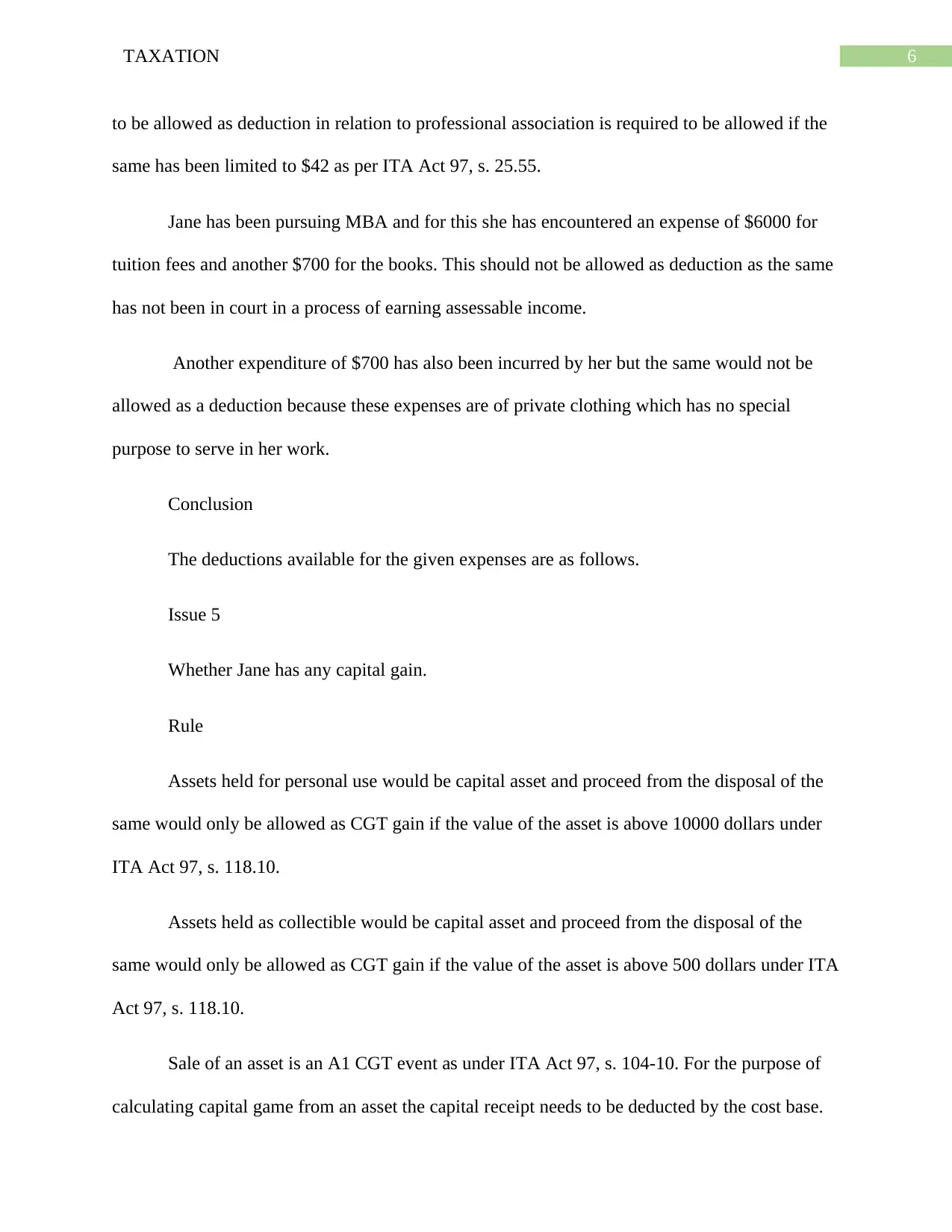
6TAXATION
to be allowed as deduction in relation to professional association is required to be allowed if the
same has been limited to $42 as per ITA Act 97, s. 25.55.
Jane has been pursuing MBA and for this she has encountered an expense of $6000 for
tuition fees and another $700 for the books. This should not be allowed as deduction as the same
has not been in court in a process of earning assessable income.
Another expenditure of $700 has also been incurred by her but the same would not be
allowed as a deduction because these expenses are of private clothing which has no special
purpose to serve in her work.
Conclusion
The deductions available for the given expenses are as follows.
Issue 5
Whether Jane has any capital gain.
Rule
Assets held for personal use would be capital asset and proceed from the disposal of the
same would only be allowed as CGT gain if the value of the asset is above 10000 dollars under
ITA Act 97, s. 118.10.
Assets held as collectible would be capital asset and proceed from the disposal of the
same would only be allowed as CGT gain if the value of the asset is above 500 dollars under ITA
Act 97, s. 118.10.
Sale of an asset is an A1 CGT event as under ITA Act 97, s. 104-10. For the purpose of
calculating capital game from an asset the capital receipt needs to be deducted by the cost base.
to be allowed as deduction in relation to professional association is required to be allowed if the
same has been limited to $42 as per ITA Act 97, s. 25.55.
Jane has been pursuing MBA and for this she has encountered an expense of $6000 for
tuition fees and another $700 for the books. This should not be allowed as deduction as the same
has not been in court in a process of earning assessable income.
Another expenditure of $700 has also been incurred by her but the same would not be
allowed as a deduction because these expenses are of private clothing which has no special
purpose to serve in her work.
Conclusion
The deductions available for the given expenses are as follows.
Issue 5
Whether Jane has any capital gain.
Rule
Assets held for personal use would be capital asset and proceed from the disposal of the
same would only be allowed as CGT gain if the value of the asset is above 10000 dollars under
ITA Act 97, s. 118.10.
Assets held as collectible would be capital asset and proceed from the disposal of the
same would only be allowed as CGT gain if the value of the asset is above 500 dollars under ITA
Act 97, s. 118.10.
Sale of an asset is an A1 CGT event as under ITA Act 97, s. 104-10. For the purpose of
calculating capital game from an asset the capital receipt needs to be deducted by the cost base.
Paraphrase This Document
Need a fresh take? Get an instant paraphrase of this document with our AI Paraphraser

7TAXATION
Application
Yacht is required be treated as an asset held for personal use. The acquisition of the same
amount equal $7,000 and hence is required been excluded from capital gains computation as
under ITA Act 97, s. 118.10.
The proceeds from antique furniture is required to be excluded from capital gain
computation as cost of each of the asset has not been above $500. But as these furnitures have
been acquired as single piece the price has exceeded $500 and is required to be treated as capital
gain.
CGT gain = $(4400-1550) = $ 2850.
Conclusion
Net CGT gain is $ 2850.
Application
Yacht is required be treated as an asset held for personal use. The acquisition of the same
amount equal $7,000 and hence is required been excluded from capital gains computation as
under ITA Act 97, s. 118.10.
The proceeds from antique furniture is required to be excluded from capital gain
computation as cost of each of the asset has not been above $500. But as these furnitures have
been acquired as single piece the price has exceeded $500 and is required to be treated as capital
gain.
CGT gain = $(4400-1550) = $ 2850.
Conclusion
Net CGT gain is $ 2850.
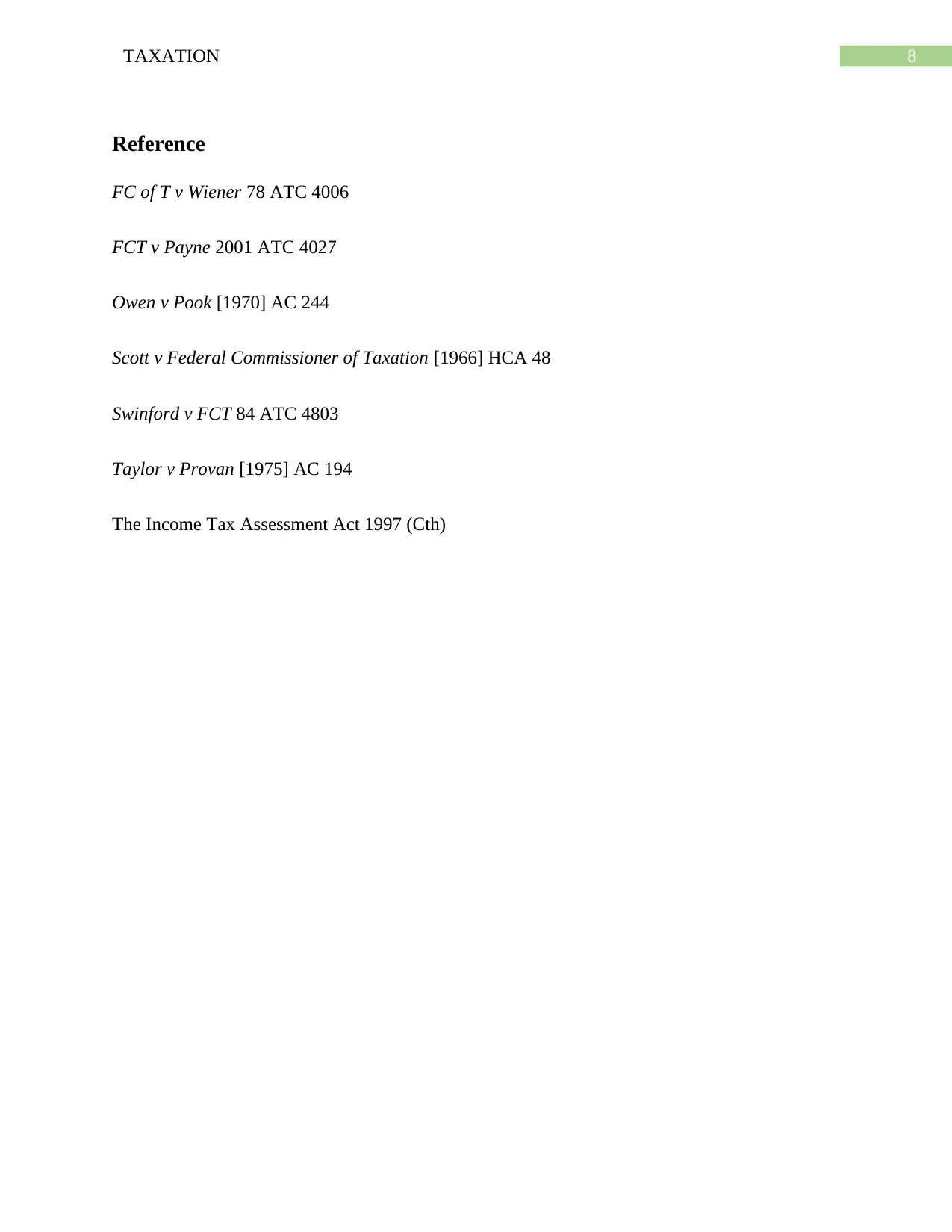
8TAXATION
Reference
FC of T v Wiener 78 ATC 4006
FCT v Payne 2001 ATC 4027
Owen v Pook [1970] AC 244
Scott v Federal Commissioner of Taxation [1966] HCA 48
Swinford v FCT 84 ATC 4803
Taylor v Provan [1975] AC 194
The Income Tax Assessment Act 1997 (Cth)
Reference
FC of T v Wiener 78 ATC 4006
FCT v Payne 2001 ATC 4027
Owen v Pook [1970] AC 244
Scott v Federal Commissioner of Taxation [1966] HCA 48
Swinford v FCT 84 ATC 4803
Taylor v Provan [1975] AC 194
The Income Tax Assessment Act 1997 (Cth)
⊘ This is a preview!⊘
Do you want full access?
Subscribe today to unlock all pages.

Trusted by 1+ million students worldwide
1 out of 9
Related Documents
Your All-in-One AI-Powered Toolkit for Academic Success.
+13062052269
info@desklib.com
Available 24*7 on WhatsApp / Email
![[object Object]](/_next/static/media/star-bottom.7253800d.svg)
Unlock your academic potential
Copyright © 2020–2025 A2Z Services. All Rights Reserved. Developed and managed by ZUCOL.





